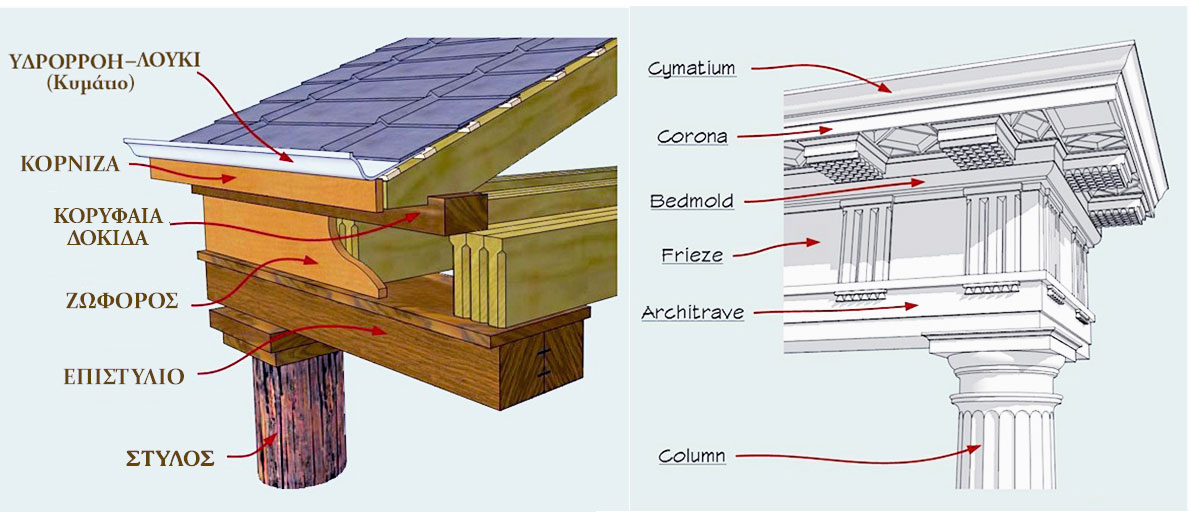Obligatory, Semester 2, ECTS: 4

Overview of Architecture History from the Classical Times (Greece & Rome) to the Renaissance. The material geographically focuses on the cultures of the Mediterranean region, with an emphasis on the intercultural relations between them. Priority is given to the works of Architecture while works of Art are discussed and analyzed to the extent that they are related to Architecture, i.e., either as an integral part of the spatial context or as interpretative tools for the comprehension of basic principles. By architecture we mean the entire built environment, which refers to the building in its context.
The examples which are presented in class are selected based on their usefulness as reference points and on their paradigmatic value for architecture; also, for their significance in the specific historical moment in which they were realized. Their analysis takes place on two levels: a) the correlation with their historical context (social, political, economic, etc.), and b) their matter-of-fact description (e.g., design principles, functionality, material and structural parameters, aesthetic assessment, etc.)
The course covers the following subjects (or periods):
• A review of Mycenae, the Dark Ages and Ancient Greece
• Ancient Rome
• Early Christian and Byzantine Periods
• Carolingian and Romanesque Periods
• Gothic Middle Ages in France and England
• Introduction to the Renaissance
COURSE ATTENDANCE
Regular attendance of the lectures and participation in all stages of the examination process are a prerequisite for the successful completion of the course and ensuring a good grade. Study aids (handouts) will be distributed at the beginning of each new thematic section whose purpose is to guide through the lectures and as study tools. Additional handouts will be distributed in the form of exercises to support every new section of the course. Students are advised to keep an orderly chronological record of all these handouts which will also form the basis of their study for the exams.
Class meetings/ lectures are scheduled for every Friday 2:00-5:00 PM. with a 10-minute break in between, if circumstances allow. For the proper functioning of the course, students are kindly requested to come in time.
Study/ field trips will be scheduled and properly announced during the semester.
The grade for the course is the sum total of two examination parts: a written examination 70% and
– A research paper on a selected topic related to the course material (30%),
OR
– A book of sketches & notes [see below for its specifications] composed on material from the instructor's presentations and the reading of the daily material (30%).
Depending on which of the two assignments the student chooses, the other (if properly executed) will grant him/her an extra bonus of 10% on the total grade.
The student is obligated to take part in the final written examination and to obtain a passing grade (5.0).
Notebook / sketchbook
This is a notebook of special specifications, which students will use during class and even beyond it, i.e., during their study, visit of various sites, museums, etc. Its purpose is to collect all the key points of the daily presentation in the form of written and pictorial information. Because it is a basic exam study tool it should be kept in good condition until the end of the semester.
In this book, each student keeps good and clear notes from the lectures as well as explanatory sketches from the visual presentation, with priority given to the architectural drawings (plans, views, sections, etc.). It may be expanded with materials that the student collects during field trips, visits to places of interest, etc. It should not be copied neither in part nor in whole.
Specifications: At least 40 sheets (80 useful pages), not bigger than A4 (21x30 cm), white or off-white, matte surface, weighing not less than 120 g.
Ordinary notebooks, i.e., of a common photocopy quality paper (70-80 g) or striped school notebooks are not acceptable.
Submission date: 2 weeks before the end of classes.
Gardner’s Art through the Ages, 11th edition, Harcourt Brace Jovanovich, Publ., San Diego, etc., 2000.
Trachtenberg, M. & Hyman, I., Architecture from Pre-History to Postmodernism, Harry N. Abrams, Inc., New York, 1986 (ήμεταγενέστερο)
Watkin, D., A History of Western Architecture, Barrie & Jenkins, London, etc., 2000.
Stokstad, Marilyn, Art History (in 2 volumes), Prentice Hall, Inc., and Harry N. Abrams, Publishers, New York, 1995
Janson, H. W., History of Art, 3rd edition, Harry N. Abrams, Inc., New York, 1986.
Sir Banister Fletcher's A History of Architecture, Dan Cruickshank (ed.), 20th edition, Architectural Press, Oxford, Boston, etc., 1996 (orig. 1896)
Kostof, Spiro, A History of Architecture: Settings and Rituals, Oxford, New York, 1985
SUPPLEMENTARY BIBLIOGRAPHY
Harris, Cyril, Illustrated Dictionary of Historic Architecture, Dover Publ., Inc., New York, 1984.
Grove's Dictionary of Art(34 τόμοι), New York, 1996 [πολύ βασικό εγκυκλοπαιδικό και βιβλιογραφικό βοήθημα]
Roth, Leland M., Understanding Architecture: Its Elements, History, and Meaning, Icon Edit., 1993.
Fleming, J., Honour, H., Pevsner, N. The Penguin Dictionary of Architecture (3rd edition), Penguin Books, London, England /New York, N.Y., 1980.
Stevens,Curl James,A Dictionary of Architecture, Oxford University Press, Oxford, England, 1999.
